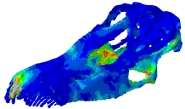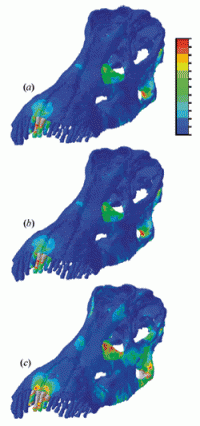A model of the Diplodocus skull showing the distribution of stresses during biting
(Phys.org) -- High-tech technology, traditionally usually used to design racing cars and aeroplanes, has helped researchers to understand how plant-eating dinosaurs fed 150 million years ago.
A team of international researchers, led by the University of Bristol and the Natural History Museum, used CT scans and biomechanical modelling to show that Diplodocus - one of the largest dinosaurs ever discovered – had a skull adapted to strip leaves from tree branches.
The research is published today in leading international natural sciences journal, Naturwissenschaften.
The Diplodocus is a sauropod from the Jurassic Period and one of the longest animals to have lived on Earth, measuring over 30 metres in length and weighing around 15 tonnes.
A reconstruction of Diplodocus feeding by artist Dmitry Bogdanov
While known to be massive herbivores, there has been great debate about exactly how they ate such large quantities of plants. The aberrant Diplodocus, with its long snout and protruding peg-like teeth restricted to the very front of its mouth, has been the centre of such controversy.
To solve the mystery, a 3D model of a complete Diplodocus skull was created using data from a CT scan. This model was then biomechanically analysed to test three feeding behaviours using finite element analysis (FEA).
FEA is widely used, from designing aeroplanes to orthopaedic implants. It revealed the various stresses and strains acting on the Diplodocus' skull during feeding to determine whether the skull or teeth would break under certain conditions.
The team that made this discovery was led by Dr Emily Rayfield of Bristol University's School of Earth Sciences and Dr Paul Barrett of The Natural History Museum in London. Dr Mark Young, a former student working at both institutions, ran the analyses during his PhD.
CT scan images of a Diplodocus skull showing 3 feeding scenarios, a. is normal biting, b. is stripping branches of leaves and c. is stripping bark. Red, orange, yellow, green, then light blue indicate the greater stress.
Dr Young said: "Sauropod dinosaurs, like Diplodocus, were so weird and different from living animals that there is no animal we can compare them with. This makes understanding their feeding ecology very difficult. That's why biomechanically modelling is so important to our understanding of long-extinct animals."
Dr Paul Barrett added: "Using these techniques, borrowed from the worlds of engineering and medicine, we can start to examine the feeding behaviour of this long-extinct animal in levels of detail which were simply impossible until recently."
Numerous hypotheses of feeding behaviour have been suggested for Diplodocus since its discovery over 130 years ago. These ranged from standard biting, combing leaves through peg-like teeth, ripping bark from trees similar to behaviour in some living deer, and even plucking shellfish from rocks.
The team found that whilst bark-stripping was perhaps unsurprisingly too stressful for the teeth, combing and raking of leaves from branches was overall no more stressful to the skull bones and teeth than standard biting.
More information: ‘Cranial biomechanics of Diplodocus (Dinosauria, Sauropoda): testing hypotheses of feeding behaviour in an extinct megaherbivore’ by Mark T. Young et al. in Naturwissenschaften.
Journal information: Naturwissenschaften
Provided by University of Bristol

.jpg)























